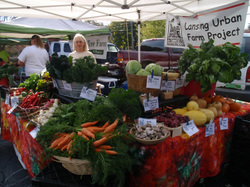
2nd Food Ethnography
Americans once shopped for food in a completely different manner then they do today. Once upon a time Americans would run down to their local market or corner store and get what food they needed for the day or next couple of days. Today’s typical Americans run to the local Wal-Mart, Kroger, Costco, or any other supermarket located in most towns across America and get the food they needed for the next couple of weeks. Most of these changes have occurred over the past 50 years, as Americans began to rely on a small number of farmers and food companies to provide the food to these “super” supermarkets. Leaving many small-scale local farmers to “die” and for the most part small farms did, but not all small farms did “die”. In fact the small local farmer seems to be making resurgence, in the form of farmer’s markets. What has allowed farmer’s markets to enjoy this resurgence? To find out this answer I took a trip to the Allen Street Farmer’s Market in Lansing to discover what makes farmer’s markets so unique.
As I walked up to Allen Street on a cold, sleet-filled Wednesday in October, one thing popped in my head; although it was a crumby day everyone present seemed to be happy. Everyone there was actually happy or at least put on a good act, as I came to find out through interactions with most of the vendors. My ignorance of farmer’s markets had me under the impression that they strictly featured only fruits and vegetables with a little bit of meat. As I walked around I soon realized it was much more than that. I made my way to Stone Circle Bakehouse, a local bread company out of Holt using simple ingredients to bake breads “the way they once tasted” (Stone). As I talked to the individuals running the stand I realized just how different the culture was at a farmer’s market compared to the supermarkets that most Americans shop at.
The people at the stand were friendly and genuinely excited to tell me about their products natural ingredients and fresh taste. They had successfully roped me in to buying some bread and my spending did not stop there as I sprung for some other products along the way. The environment had my interest peaked. The people made a huge difference, but ultimately knowing where all the food came from was the biggest factor for me. 1500 miles is the average distance food travels in the United States before it gets to us (the consumers) according to many locavore movements. From my baseline information of the Allen Street Farmer’s Market the food was traveling no more than 30 miles and as little as a couple of blocks, where some of the urban farmers grow their produce.
Because this food comes from local producers, people can sometimes have the misconception that farmer’s markets are only for people who are willing to spend lots of money on food. As I was walking around, I noticed the prices of the fruits and vegetables and they seemed reasonable, according to my limited knowledge of fruit and vegetable prices. Even if they were a bit more expensive, to me it seemed worth it to know that my food was coming from somewhere close and it would be helping people within the community. Also, as I discovered that at each stand they accepted bridge card tokens and food stamp tokens, therefore making it more accessible to lower income individuals. As I was buying products I realized that it was alright to negotiate for them, something that had completely caught me off guard. This was one of the biggest and best cultural differences between the traditional American supermarket and the Allen Street Farmer’s Market.
As I was walking away from the farmer’s market my mood can be described simply as jolly, I had never left somewhere that I bought food feeling so satisfied and happy. The culture of the farmer’s market had brightened my day, from the people, to the products, to the excessive amount of “hippie” bumper stickers. I realized that having the counterculture to the American supermarket was what had made my experience so great and has allowed farmer’s markets to grow across America. Although my experience as a whole was great, I see a large flaw in farmer’s markets especially in northern states. Most are only open from May to October; therefore, forcing people to turn to the traditional supermarket where the food is often not as fresh and travels on average 1500 miles. Ultimately, I think farmer’s markets are a great long-term supplement to American supermarkets, somewhere we can all go to get local fresh food products.
Work Cited
"Agricultural Marketing Service - Farmers Markets and Local Food Marketing." Agricultural Marketing Service - Farmers Markets and Local Food Marketing. USDA, 3 Aug. 2013. Web. 28 Oct. 2013.
"Stone Circle Bake House." Stone Circle Bakehouse. N.p., n.d. Web. 30 Oct. 2013. <http://www.stonecirclebakehouse.com/>.
Americans once shopped for food in a completely different manner then they do today. Once upon a time Americans would run down to their local market or corner store and get what food they needed for the day or next couple of days. Today’s typical Americans run to the local Wal-Mart, Kroger, Costco, or any other supermarket located in most towns across America and get the food they needed for the next couple of weeks. Most of these changes have occurred over the past 50 years, as Americans began to rely on a small number of farmers and food companies to provide the food to these “super” supermarkets. Leaving many small-scale local farmers to “die” and for the most part small farms did, but not all small farms did “die”. In fact the small local farmer seems to be making resurgence, in the form of farmer’s markets. What has allowed farmer’s markets to enjoy this resurgence? To find out this answer I took a trip to the Allen Street Farmer’s Market in Lansing to discover what makes farmer’s markets so unique.
As I walked up to Allen Street on a cold, sleet-filled Wednesday in October, one thing popped in my head; although it was a crumby day everyone present seemed to be happy. Everyone there was actually happy or at least put on a good act, as I came to find out through interactions with most of the vendors. My ignorance of farmer’s markets had me under the impression that they strictly featured only fruits and vegetables with a little bit of meat. As I walked around I soon realized it was much more than that. I made my way to Stone Circle Bakehouse, a local bread company out of Holt using simple ingredients to bake breads “the way they once tasted” (Stone). As I talked to the individuals running the stand I realized just how different the culture was at a farmer’s market compared to the supermarkets that most Americans shop at.
The people at the stand were friendly and genuinely excited to tell me about their products natural ingredients and fresh taste. They had successfully roped me in to buying some bread and my spending did not stop there as I sprung for some other products along the way. The environment had my interest peaked. The people made a huge difference, but ultimately knowing where all the food came from was the biggest factor for me. 1500 miles is the average distance food travels in the United States before it gets to us (the consumers) according to many locavore movements. From my baseline information of the Allen Street Farmer’s Market the food was traveling no more than 30 miles and as little as a couple of blocks, where some of the urban farmers grow their produce.
Because this food comes from local producers, people can sometimes have the misconception that farmer’s markets are only for people who are willing to spend lots of money on food. As I was walking around, I noticed the prices of the fruits and vegetables and they seemed reasonable, according to my limited knowledge of fruit and vegetable prices. Even if they were a bit more expensive, to me it seemed worth it to know that my food was coming from somewhere close and it would be helping people within the community. Also, as I discovered that at each stand they accepted bridge card tokens and food stamp tokens, therefore making it more accessible to lower income individuals. As I was buying products I realized that it was alright to negotiate for them, something that had completely caught me off guard. This was one of the biggest and best cultural differences between the traditional American supermarket and the Allen Street Farmer’s Market.
As I was walking away from the farmer’s market my mood can be described simply as jolly, I had never left somewhere that I bought food feeling so satisfied and happy. The culture of the farmer’s market had brightened my day, from the people, to the products, to the excessive amount of “hippie” bumper stickers. I realized that having the counterculture to the American supermarket was what had made my experience so great and has allowed farmer’s markets to grow across America. Although my experience as a whole was great, I see a large flaw in farmer’s markets especially in northern states. Most are only open from May to October; therefore, forcing people to turn to the traditional supermarket where the food is often not as fresh and travels on average 1500 miles. Ultimately, I think farmer’s markets are a great long-term supplement to American supermarkets, somewhere we can all go to get local fresh food products.
Work Cited
"Agricultural Marketing Service - Farmers Markets and Local Food Marketing." Agricultural Marketing Service - Farmers Markets and Local Food Marketing. USDA, 3 Aug. 2013. Web. 28 Oct. 2013.
"Stone Circle Bake House." Stone Circle Bakehouse. N.p., n.d. Web. 30 Oct. 2013. <http://www.stonecirclebakehouse.com/>.


 RSS Feed
RSS Feed